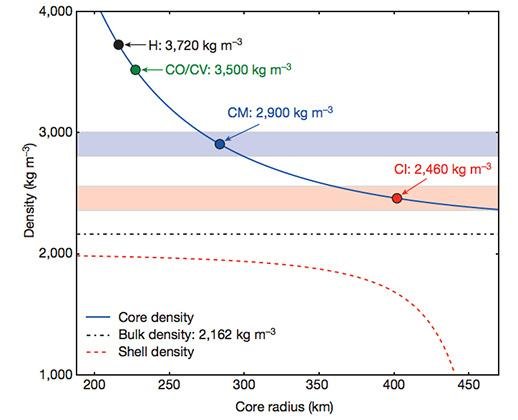Inside Ceres discovered giant nucleus

Scientists from the US, France and Germany have identified an exemplary internal structure of the dwarf planet Ceres - the largest celestial body in the asteroid belt between the orbits of Mars and Jupiter. The study is published in the journal Nature.
Ceres is located inside a large rocky core, the density of which reaches 2,46-2,9 thousand kilograms per cubic meter. The core is covered by a shell, which reaches a thickness of 70-190 kilometers, and density - 1,68-1,95 thousand kilograms per cubic meter.
Most likely, the outer shell comprises a mixture of volatile compounds and thicker materials, while Ceres, the core consists of chondrites. Average normalized moment of inertia of Ceres was equal to 0.37.
Scientists from the US, France and Germany have identified an exemplary internal structure of the dwarf planet Ceres - the largest celestial body in the asteroid belt between the orbits of Mars and Jupiter. The study is published in the journal Nature.
Ceres is located inside a large rocky core, the density of which reaches 2,46-2,9 thousand kilograms per cubic meter. The core is covered by a shell, which reaches a thickness of 70-190 kilometers, and density - 1,68-1,95 thousand kilograms per cubic meter.
Most likely, the outer shell comprises a mixture of volatile compounds and thicker materials, while Ceres, the core consists of chondrites. Average normalized moment of inertia of Ceres was equal to 0.37.

The density of Ceres, depending on the distance from its center
By its conclusions scientists came after analysis of data obtained Dawn station. According to planetary scientists, evolution of Ceres is more complicated manner than another celestial body from the asteroid belt - Vesta.
Dawn station launched September 27, 2007 by a rocket Delta 2 from the spaceport at Cape Canaveral in the US and in orbit around Ceres was March 6, 2015. Cost of the project for the study of the asteroid Vesta and the dwarf planet Ceres, is about 500 million dollars.
Ceres, discovered in 1801 by Italian Giuseppe Piazzi and is named after the Roman goddess of fertility. The diameter of the space object is about 950 kilometers, making it the largest celestial body in the asteroid belt between the orbits of Mars and Jupiter.
A source: https://newsland.com